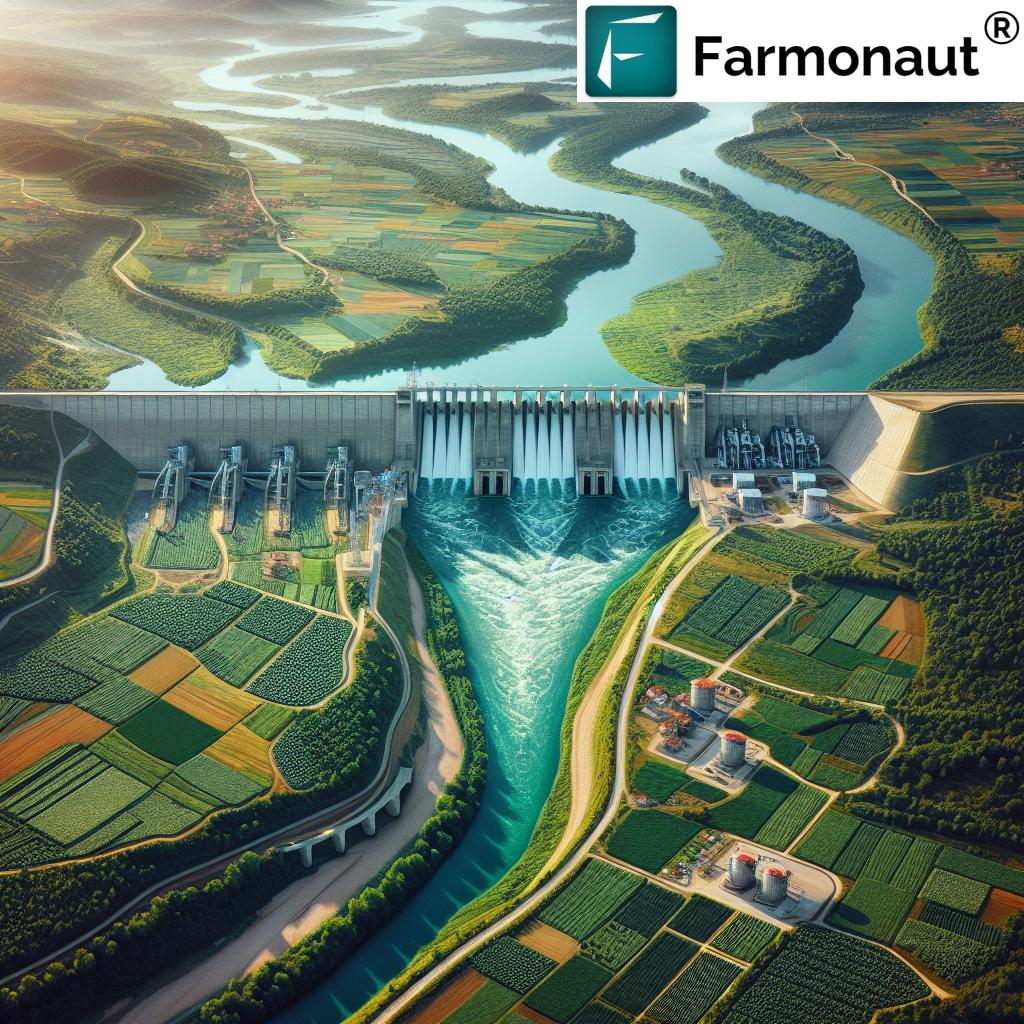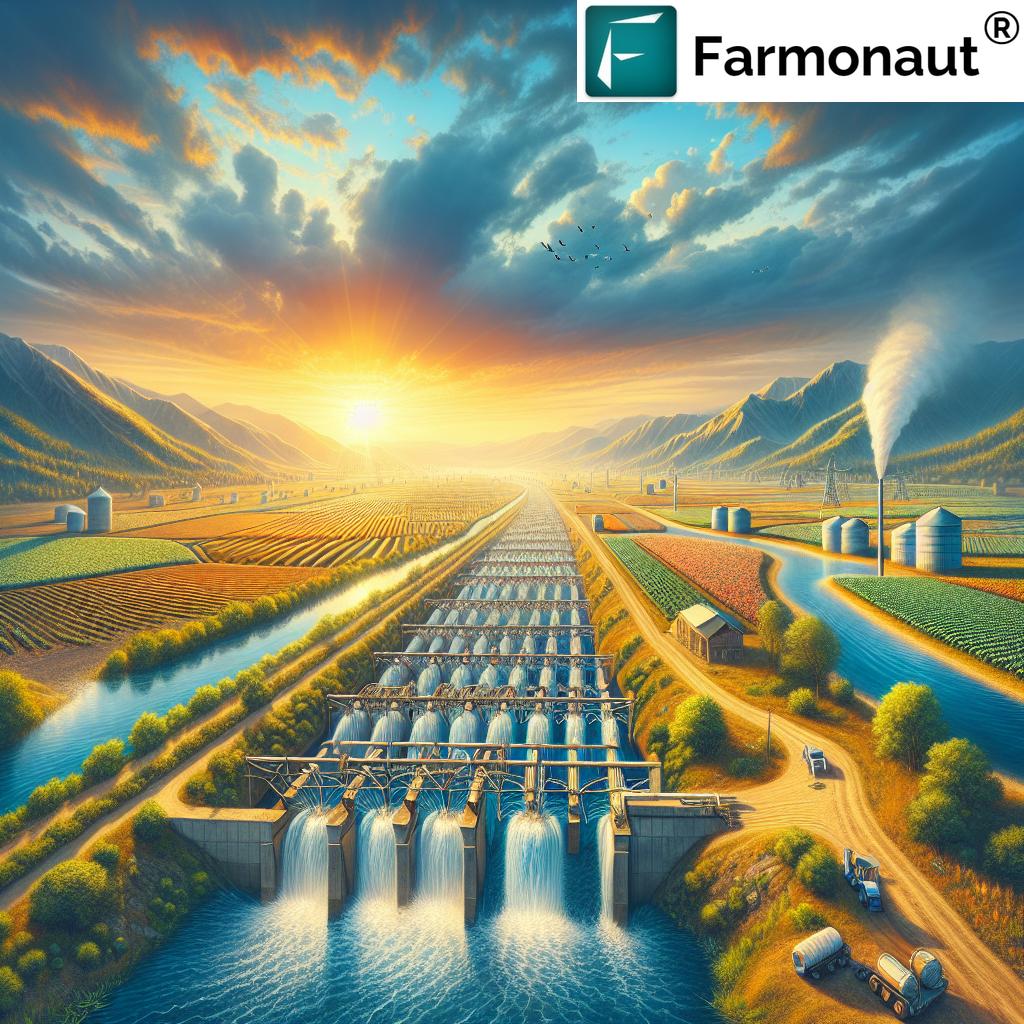Arda River: Ensuring Sustainable Irrigation in Northern Greece
” The Arda River supplies water to over 100,000 hectares of farmland in Northern Greece, supporting sustainable agriculture. ”
Table of Contents
- Introduction: The Arda River and Its Importance
- Arda River: Geography and Aquatic Ecosystem
- Historical Context: Bulgaria–Greece Water Agreement
- 2024 Agreement Renewal: Cross-Border Water Management
- Arda River Irrigation System and Dams in Bulgaria
- Impact of Regulated Water Supply on Irrigation in Northern Greece
- Water Resources for Agriculture: Ensuring Food Security and Biodiversity
- Safeguarding the Arda River Aquatic Ecosystem
- Farmonaut & Technology in Sustainable Water Resource Management
- Comparative Arda River Irrigation Data Table
- Moving Forward: Modernization, Dam Construction & Review Mechanisms
- Frequently Asked Questions (FAQ)
- Conclusion
- Farmonaut Subscription Plans
Introduction: The Arda River and Its Role in Sustainable Irrigation in Northern Greece
Water is our planet’s lifeblood, nourishing both human activities and natural ecosystems. Among the many rivers that shape the destinies of nations, the Arda River stands out for its central role in sustaining agriculture, enhancing biodiversity, and fostering cross-border cooperation between Bulgaria and Greece. In 2024, the Arda River water supply became a focal point in regional sustainability when Bulgaria and Greece reaffirmed their commitment to regulated, equitable, and ecologically responsible water management for the next five years. This blog explores the Bulgaria Greece water agreement, the complex Arda River irrigation system, and the broader context of water resources for agriculture and the fragile ecosystem in the Evros border region.
By delving into this river’s significance, the functioning of extensive Arda dams Bulgaria, and the cross-border strategies for sustainable provision, we aim to shed light on how the Arda secures food, livelihoods, and habitat for countless species. Join us as we navigate the past, present, and future of sustainable irrigation in Northern Greece—all rooted in one vital river.
Arda River: Geography, Flow, and Its Vital Aquatic Ecosystem
Originating in Bulgaria’s Rhodope Mountains, the Arda River winds for 272 kilometers, of which 241 km cross Bulgarian territory before gracefully entering Greece near the border. With a total annual discharge that ranks third among Bulgarian rivers, the Arda is not just a geographical feature but a living artery for two countries.
- Length: 272 km (241 km in Bulgaria, rest in Greece)
- Total volume and flow: The river delivers an average full-flow discharge, providing a significant, stable water supply for thousands of hectares of arable land in Northern Greece.
- Aquatic ecosystem: The diverse ecological zones along its course sustain a variety of fish, amphibians, invertebrates, and riparian plants, creating a biodiversity hotspot in the Evros region.
The Arda River water supply directly supports vast agricultural lands on Greek territory—these lands are otherwise reliant solely on rainfall, which has become increasingly unpredictable due to climate change and shifting regional water reserves.
” The Bulgaria-Greece water agreement helps maintain ecological balance for more than 50 aquatic species in the Arda River basin. ”
Bulgaria–Greece Water Agreement: A Legacy of Sustainable Water Resource Provision
The roots of the Bulgaria Greece water agreement trace back to 1964. In that pivotal year, both countries formalized a bilateral agreement to ensure the continuous and sufficient provision of regulated water volumes from Bulgaria (upstream) to Greece (downstream).
This agreement has ensured:
- Irrigation of over 817,000 hectares of arable Greek lands in Northern Evros directly via the Arda, and the indirect irrigation of about 400,000 hectares via related rivers (including the Mesta).
- Consistent water supply: Bulgaria committed to the accumulation, storage, and regulated supply of water volumes—balancing its own needs with international obligations.
- Cross-border management: Both governments agreed on cost reimbursement mechanisms, ecological safeguards, and joint monitoring of river quality and aquatic ecosystems.
Over time, this service of regulated supply has evolved into a model for cross-border water management, inspiring similar agreements in other water-scarce regions.
2024 Renewal: Modernizing the Arda River Water Supply for Irrigation in Northern Greece
At the start of July 2024, this 60-year-old agreement was set to expire. Recognizing the Arda River’s irreplaceable role for agriculture and ecosystems, the Bulgarian and Greek Ministers of Foreign Affairs—Georg Georgiev and Georgios Gerapetritis—signed a new joint declaration in Sofia. Endorsed by both governments, this historic renewal:
- Extends regulated water supply Bulgaria for five more years (reviewable after that period).
- Ensures Bulgaria continues the accumulation, storage, and regulated supply of water through the Arda cascade dams system for irrigation in Northern Greece.
- Mandates Greece to reimburse costs for the water management service.
- Signals an intention for the future construction or modernization of dams and water infrastructure on Greek territory.
The new Bulgaria Greece water agreement particularizes commitments for transparent operation, shared costs, and flexibility to adjust to demand fluctuations, especially during severe summer droughts.
In summer 2024, for instance, Greece specifically requested and received 80 million cubic metres of extra water to alleviate shortages in both the Arda and Mesta rivers, emphasizing the critical nature of a responsive, data-driven supply system.
This agreement was swiftly approved by the Bulgarian council of ministers and publicly welcomed by the Greek ministry of foreign affairs. Both sides have underscored their intention to periodically review the terms for ongoing sustainability and fairness.
Arda River Irrigation System: The Arda Cascade Dams in Bulgaria
On Bulgarian territory, the Arda River irrigation system is among the most advanced in the region due to proactive infrastructure development. Uniquely, the Arda is dammed at three major sites, forming the only system of large dams on a single river in the country. These cascade dams are critical to achieving the desired regulated water supply Bulgaria promises:
- Total volume: Combined, the Arda dams Bulgaria amass a storage capacity exceeding 1.2 billion cubic metres—buffering annual flows and stabilizing supply even during dry seasons.
- Function: Dams are utilized for accumulation and storage as well as for power generation, but their critical role is in ensuring continuous water supply to Greece as per the bilateral agreement.
- Regulated flow management: Through advanced reservoir operations, water is released in accordance with predefined volumetric agreements, local needs in Bulgaria, and downstream requirements in Greek agricultural lands.
- Modernization potential: Ongoing plans for new dam construction or upgrades in both countries further strengthen this resilient irrigation infrastructure.
This cascade dam system underscores best practices in long-term cross-border water management—serving as both a buffer and a regulator of water resources for agriculture across the region.
Impact of Regulated Water Supply Bulgaria: Irrigation in Northern Greece
The direct outcome of the Arda River water supply is seen in the flourishing agricultural production of the Northern Greek regions—primarily in Evros prefecture and surrounding arable lands. The system established by the bilateral agreement and maintained by the cascade dams secures the following:
- Reliable agricultural water provision: Over 817,000 hectares are directly irrigated, sustaining staple crops, industrial-scale grain, and horticulture.
- Protection against droughts: During extreme summer periods or when local reserves shrink, Bulgaria’s regulated storage and controlled supply proved critical—as highlighted by the 80 million cubic metres provided in mid-2024.
- Boosted food security and exports: Predictable irrigation ensures stable yields, lowering risks for farmers and supporting regional economic stability.
- Support for rural employment: With reliable Arda River irrigation system functioning, farm jobs are protected, and investments in modernized technologies become more viable.
Indirectly, controlled water volumes also sustain the water table, recharge local aquifers, and mitigate the adverse effects of climate variability across the region.
Optimize your farm’s sustainability, traceability, and compliance with:
- Farmonaut’s Carbon Footprinting tools – track, analyze, and reduce farm greenhouse emissions for regulatory compliance and a lower carbon footprint.
Comparative Data Table: Arda River Irrigation and the Bulgaria–Greece Water Agreement
| Parameter | Estimated Value | Relevant Year or Period |
|---|---|---|
| Average Annual Arda River Discharge | ~1.2 billion cubic metres (total dam volume) | 2024 |
| Directly Irrigated Area in Northern Greece | ~817,000 hectares | 1964–2024; Extended to 2029 |
| Indirectly Irrigated Area via Related Rivers | ~400,000 hectares | 1964–2024 |
| Annual Water Volume Supplied (Five-Year Agreement) | ~80 million cubic metres (2024 requested amount) | 2024–2029 |
| % Water Allocated to Greece (per agreement) | Determined annually based on Greek irrigation needs; substantial majority of downstream flow | Annually adjusted |
| Crop Yield Increase Attributed to Irrigation | Up to 250% compared to rainfed plots | On average, annually |
| Aquatic Species Diversity Index (Basin estimate) | >50 species maintained by agreed river flows | 2024 estimates |
| Agreement Start Year / Review Schedule | 1964 initial; Renewed 2024; 5-year review cycles | 1964–2029 |
Water Resources for Agriculture: Sustainable Food Security and Biodiversity in the Arda Region
Access to predictable, regulated water supply underpins sustainable agriculture. The Arda River irrigation system not only sustains major food and cash crops but also supports animal husbandry, horticulture, and agri-processing industries in Northern Greece. As the climate grows less predictable:
- Precision farming technologies like Farmonaut’s real-time crop health monitoring become crucial for maximizing yields with available water and reducing input waste.
- Efficient distribution and minimal loss are priorities, supported by innovations in flood/drought forecasting and data-driven irrigation scheduling.
By sustaining agriculture across hundreds of thousands of hectares, the Arda ensures food security for our communities and generates export infusions to both countries’ economies. Simultaneously, the regulation of water volumes helps preserve wetland habitats and supports the region’s ecosystem against the twin pressures of human use and climate variability.
- For supply chain managers and agri-exporters, Farmonaut’s Traceability platform brings blockchain-backed transparency to product journeys, boosting authenticity and consumer trust.
Arda River Aquatic Ecosystem: Maintaining Cross-Border Ecological Balance
Effective cross-border water management under the renewed Bulgaria Greece water agreement is not just about meeting agricultural needs—it’s also about safeguarding the river’s aquatic ecosystem. The Arda basin is home to over 50 aquatic species, many of which rely on steady river flows and the absence of abrupt changes to their habitat.
- Continuous monitoring by both countries’ ministries ensures that the ecosystem does not suffer from over-extraction or reduced flows.
- Coordinated dam operations allow for environmental flow releases, maintaining water quality, natural sediment transport, and sufficient habitat space for fish and other fauna.
- Balanced water allocation also supports riparian vegetation, migratory birds, and endemic species found only in the Evros and adjacent valleys.
- Provisions for periodic environmental review of the service ensure adaptation to evolving conservation science and regional priorities.
The Arda River irrigation system thus operates at the intersection of human sustenance and ecological responsibility, setting a regional standard for sustainable agriculture without compromising biodiversity.
- For large-scale farm businesses, Farmonaut’s Fleet Management module enables efficient vehicle and equipment tracking, helping optimize resource use and minimize transportation costs across vast irrigated holdings.
Technology for Sustainable Irrigation: Farmonaut at the Water Management Frontier
ERP systems, telemetry, and climate-smart tools are now pillars for farm and resource managers. As the Arda River water supply enters a new era, digital innovation and satellite-driven management are key to unlocking greater efficiency and accountability for all stakeholders—from ministries to local cooperatives and farmers.
Farmonaut is at the vanguard of this change, providing:
- Web, Android, and iOS Apps for real-time crop health monitoring via satellite imagery (NDVI, soil moisture, pest hotspots)— informing optimal irrigation decisions and resource allocation.
- AI-powered advisory (Jeevn AI) to generate customized, data-driven strategies for farmers navigating unpredictable rainfall and shifting resource availability.
- Blockchain-based traceability for transparency in agricultural supply chains, a growing priority for both public policy and export standards.
- Resource and Fleet Management tools that help operators optimize movement of inputs, machinery, and produce—maximizing gains from every drop of water.
- Carbon footprinting so stakeholders can track and systematically reduce farming’s environmental impact, aligned with regional sustainability goals.
To those who need flexible integration or wish to leverage best-in-class APIs for cross-border water management analytics, Farmonaut also provides:
Farmonaut Water & Crop Monitoring API (for seamless developer access to live satellite and weather insights across vast hectares).
API Developer Docs
- For governmental agencies and cooperatives, explore Farmonaut’s Large-Scale Farm Management dashboard—offering portfolio-wide monitoring, reporting, and compliance tools for state or NGO-managed irrigation programs.
Modernization, Dam Construction, and the Future of the Arda River Water Supply System
As the Bulgaria Greece water agreement embarks on its next five-year phase, several modernization opportunities and review mechanisms are in focus:
- Construction of new dams: The Greek government has specifically announced intentions to modernize existing dams or construct new ones as part of a long-term water security strategy for the region.
- Smart resource management: Greater adoption of satellite-driven insights and IoT-based controls will allow finer regulation of accumulation, storage, and supply—helping navigate both wet and dry periods.
- Periodic review: The current joint declaration is valid for five years, after which both countries will assess progress and sustainability, adapting the regulation as needed.
- Service cost transparency: The agreement provides that Greece will reimburse Bulgaria for the service of regulated supply, with costs clarified and reviewed per actual volumes delivered.
- Continued ecosystem protection: Regular environmental reviews will ensure the Arda’s aquatic ecosystem thrives alongside agricultural productivity, sustaining the region’s biodiversity for future generations.
In an era of mounting climate uncertainty, this model—combining robust infrastructure, cross-border trust, and digital innovation—points the way forward for sustainability in water-stressed regions worldwide.
Frequently Asked Questions (FAQ) on Arda River and Sustainable Irrigation
What is the main role of the Arda River in Northern Greece?
The Arda River provides regulated water volumes essential for the sustainable irrigation of vast agricultural lands in Northern Greece. Without its water resources, agriculture and the local ecosystem would be severely impacted.
What are the key provisions of the Bulgaria Greece water agreement?
The agreement ensures regulated, reviewed, and cost-reimbursed provision of water from Bulgaria’s Arda cascade dams to Greek territory for agricultural purposes, with periodic reviews, modernization initiatives, and a focus on ecological sustainability.
How does the Arda River irrigation system function?
It utilizes three large cascade dams on the Bulgarian side to accumulate, store, and release regulated water flows downstream, buffering seasonal or climatic variability and supporting the ongoing needs of Greek farmers.
What are the sustainability benefits for the regional ecosystem?
Sustainable water provision helps maintain river flows supporting over 50 aquatic species, preserves wetland habitats, and enables both food security and biodiversity in line with environmental best practices.
How do digital platforms like Farmonaut help?
Farmonaut provides satellite-based crop monitoring, AI advisory, and resource management solutions, enabling more precise, efficient, and data-driven management of crops and irrigation at all scales, complementing large infrastructure like the Arda dams.
What does the next five-year plan involve?
It extends the joint declaration, calls for dam modernization/construction in Greece, and emphasizes continuous review of both technical and ecological aspects, including cost transparency and adaptive management to new climate or agricultural challenges.
Conclusion: The Arda River—A Lifeline for Sustainable Agriculture and Ecosystems
The story of the Arda River water supply is a compelling example of how international cooperation, solid agreements, and forward-thinking resource management can deliver powerful outcomes for food security, economic stability, and ecological preservation. With its regulation guided by robust policy frameworks and empowered by digital innovation, the Arda stands as a blueprint for sustainable irrigation in the face of evolving global challenges and climate shifts.
As we look ahead, the integration of modern dam construction for irrigation, advanced data analytics, and continual review will ensure the Arda remains a reliable partner both for farmers and for nature. By aligning the needs of agriculture with those of the wider ecosystem, Bulgaria and Greece set an inspiring precedent—proving that sustainability and productivity can flow together, just like the river that sustains them both.
Farmonaut Subscription Plans: Optimize Your Farm with Precision Technology
Farmonaut offers flexible, scalable subscription options suitable for everyone—from individual farmers monitoring under 20 hectares to large enterprises managing thousands of hectares across borders. Enjoy access to live satellite crop updates, AI advisory, compliance and carbon footprinting tools, and resource management dashboards via mobile and web apps or custom APIs.
Explore live pricing and get started:
















